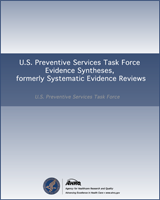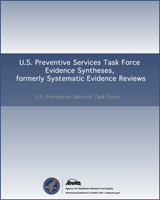NCBI Bookshelf. A service of the National Library of Medicine, National Institutes of Health.
This publication is provided for historical reference only and the information may be out of date.
Structured Abstract
Background:
Intimate partner violence (IPV) and abuse of elders and vulnerable persons is common in the United States and often undetected. Screening individuals without obvious signs of abuse in health care settings could identify those at risk and lead to interventions that reduce exposure to violence and abuse and improve health outcomes.
Purpose:
To update the previous 2004 evidence report on screening for IPV and abuse of elders and vulnerable persons for the U.S. Preventive Services Task Force (USPSTF).
Data Sources:
We reviewed the Cochrane Central Register of Controlled Trials and Cochrane Database of Systematic Reviews through the fourth quarter of 2011, and MEDLINE and PsycINFO from 2002 to January 9, 2012, for relevant English-language studies, systematic reviews, and meta-analyses. Reference lists of papers and citations of key studies were reviewed manually and by using Scopus.
Study Selection:
The screening population included adults who have no obvious signs or symptoms of abuse who interact with health care providers in a number of health care settings. Studies were selected based on preestablished selection criteria using randomized, controlled trials to determine the effectiveness of screening and interventions to reduce abuse and improve health outcomes; studies of diagnostic accuracy to evaluate the ability of screening instruments to identify abused individuals; and studies of any design to determine harms of screening and interventions.
Data Extraction:
For studies of screening and interventions, information about the patient populations, study designs, screening methods, types of interventions, followup, methods of analysis, and results were abstracted. For studies of screening instruments, details about the study designs, instruments, reference standards, populations, methods of administration, and results were abstracted. Predefined criteria developed by the USPSTF were used to rate the quality of studies as good, fair, or poor.
Data Synthesis:
For IPV, a randomized, controlled trial comparing IPV screening versus no screening in Canadian health care settings indicated that both groups had reductions in IPV recurrence, post-traumatic stress disorder symptoms, and alcohol problems, as well as improvements in scores for quality of life, depression, and mental health after 18 months of followup; however, differences between groups were not statistically significant for these outcomes. Six instruments with 1 to 8 items demonstrated sensitivity and specificity >80 percent in clinical populations of asymptomatic women; results varied between studies and across instruments. A trial of pregnant women reported decreased violence and improved birth outcomes with counseling versus usual care. Two trials of home visitation versus no visitation for young mothers resulted in improved outcomes with visitation. Counseling resulted in decreased pregnancy coercion and resolution of unsafe relationships versus usual care in one trial. Two trials of counseling showed improved outcomes in intervention and control groups without differences between them (counseling vs. referral cards, nurse management vs. usual care in pregnancy).
For abuse of elder and vulnerable adults, few studies met inclusion criteria. A descriptive study of elderly abused veterans who were identified in primary care clinics and referred to case management found that 5 percent were reported to Adult Protective Services and 6 percent required nursing home placement or conservatorship arrangements. A single instrument, the Elder Abuse Suspicion Index, was evaluated for diagnostic accuracy and had sensitivity and specificity of 9 to 47 percent and 75 to 97 percent, respectively, depending on the number of positive responses to specific questions.
Limitations:
Studies of IPV were limited by heterogeneity, lack of true control groups, high and/or differential loss to followup, self-reported measures, inadequate power, recall bias, missing data, Hawthorne effect among control participants, and reference standards that were not credible or replicable in diagnostic accuracy studies. Studies of elder and vulnerable adult abuse were lacking.
Conclusions:
A trial of screening showed reductions in IPV recurrence and improvement in related outcomes for both screening and comparison groups, but interpretations are limited by high attrition and the Hawthorne effect. Trials of IPV interventions for pregnant women and young mothers showed improved outcomes for the intervention versus usual care groups. Several instruments have been developed for IPV screening; six instruments with 1 to 8 items demonstrated sensitivity and specificity >80 percent in clinical populations of asymptomatic women, although results varied between studies and across instruments. Studies were lacking to address screening elderly and vulnerable adults for abuse.
Contents
Acknowledgements: The authors acknowledge Shelley Selph, MD, MPH, Oregon Health & Science University, and Laurie Hoyt Huffman, MS, for their contributions to the report. We also acknowledge Tracy Dana, MLS, Oregon Health & Science University, for conducting literature searches. We thank the Medical Officer for this project, Charlotte Mullican, BSW, MPH, AHRQ; U.S. Preventive Services Task Force leads David Grossman, MD, MPH, Bernadette Melnyk, PhD, RN, and Adelita Gonzales Cantu, PhD, RN; and Mary Barton, MD, MPP.
Prepared for: Agency for Healthcare Research and Quality, U.S. Department of Health and Human Services1, Contract No. HHSA-290-2007-10057-I-EPC3, Task Order No. 3, Prepared by: Oregon Evidence-based Practice Center, Oregon Health & Science University2
Suggested citation:
Nelson HD, Bougatsos C, Blazina I. Screening Women for Intimate Partner Violence and Elderly and Vulnerable Adults for Abuse: Systematic Review to Update the 2004 U.S. Preventive Services Task Force Recommendation. Evidence Synthesis No. 92. AHRQ Publication No. 12-05167-EF-1. Rockville, MD: Agency for Healthcare Research and Quality; May 2012.
This report is based on research conducted by the Oregon Evidence-based Practice Center (EPC) under contract to the Agency for Healthcare Research and Quality (AHRQ), Rockville, MD (Contract No. 290-02-0024). The investigators involved have declared no conflicts of interest with objectively conducting this research. The findings and conclusions in this document are those of the author(s), who are responsible for its content, and do not necessarily represent the views of AHRQ. No statement in this report should be construed as an official position of AHRQ or of the U.S. Department of Health and Human Services.
The information in this report is intended to help clinicians, employers, policymakers, and others make informed decisions about the provision of health care services. This report is intended as a reference and not as a substitute for clinical judgment.
This report may be used, in whole or in part, as the basis for the development of clinical practice guidelines and other quality enhancement tools, or as a basis for reimbursement and coverage policies. AHRQ or U.S. Department of Health and Human Services endorsement of such derivative products may not be stated or implied.
- 1
540 Gaither Road, Rockville, MD 20850; www
.ahrq.gov - 2
Mail Code: BICC, 3181 SW Sam Jackson Park Road, Portland, OR 97239; www
.ohsu.edu/epc
- Screening Women for Intimate Partner Violence and Elderly and Vulnerable Adults ...Screening Women for Intimate Partner Violence and Elderly and Vulnerable Adults for Abuse
- SRS7649375 (1)SRA
- SRS555905 (2)SRA
- photosystem II protein D1, partial (chloroplast) [Metastelma peruvianum]photosystem II protein D1, partial (chloroplast) [Metastelma peruvianum]gi|2184269116|gb|UJT65809.1|Protein
- Conophytum minutum var. minutum voucher Zhigila, Schmiedel & Muasya 1323 interna...Conophytum minutum var. minutum voucher Zhigila, Schmiedel & Muasya 1323 internal transcribed spacer 1, partial sequence; 5.8S ribosomal RNA gene, complete sequence; and internal transcribed spacer 2, partial sequencegi|2557475270|gb|OR392050.1|Nucleotide
Your browsing activity is empty.
Activity recording is turned off.
See more...

